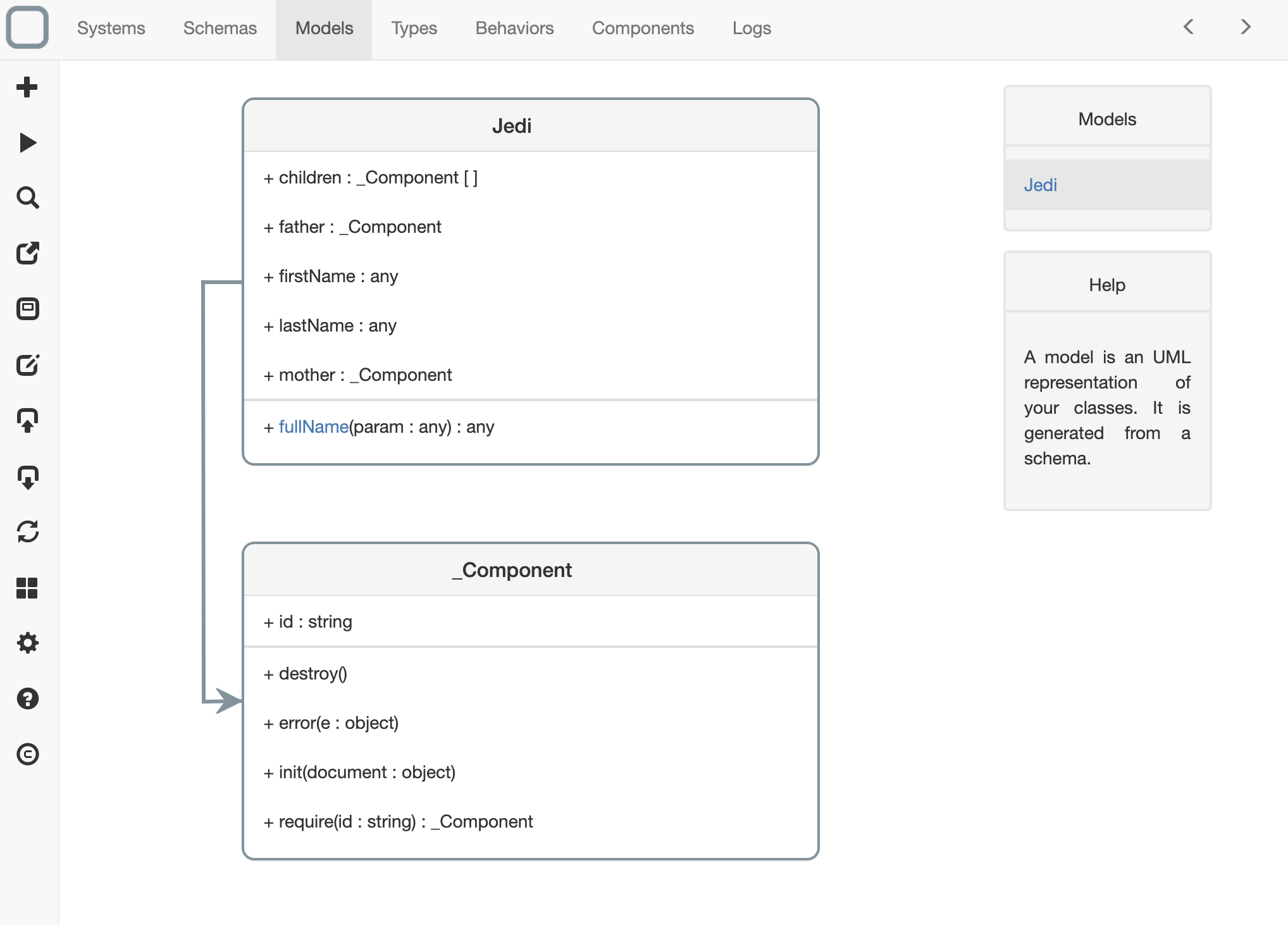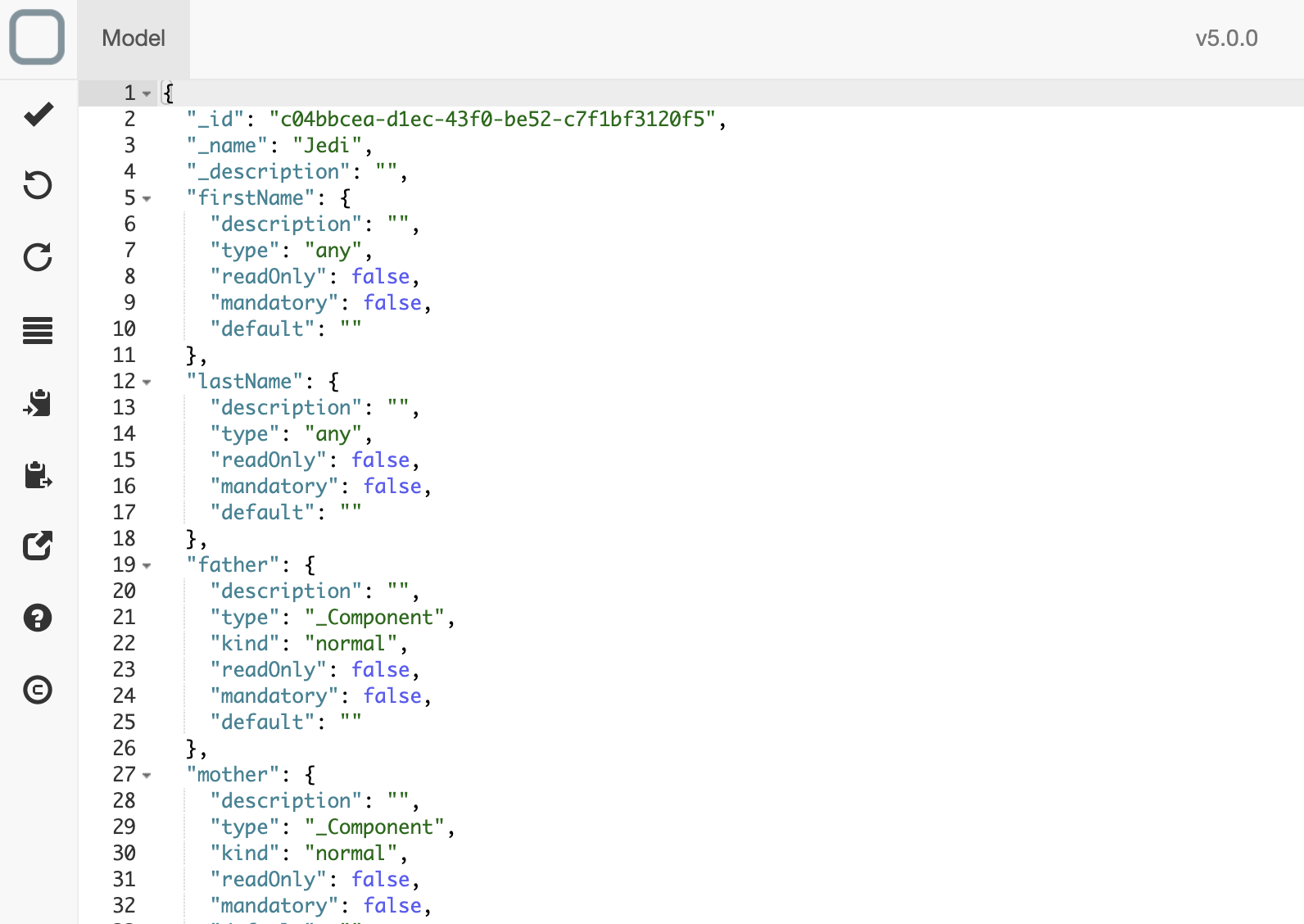Edit a model
A model is the UML representation of the class that you will use in your system. You can edit these models and update many informations (type, default value, ...).
打開你的模型一覽
To vies your models in System Designer:
- 點擊切換置 Models 頁,
- 然後你會看到由模式產生的模型一覽

Edit a model
- 點擊你要編擊的模型名,
- 編輯器會切換至模型編輯頁,
- 然後你就可以開始對模型追加特性了

What is a configuration?
為你的物件定義行為;包含特性,連結,集合,方法,事件。
What types can be set in models?
System Designer manages by default these types: - boolean, string, number, array, date: standard types, - object: for non typed object, - css, html, javascript, json, text: for live editing of CSS, HTML, JavaScript, JSON or a text and - any: for any kind of type.
You can also define: - your own type (enum typed or typed object) or - a model.
What is the default value for a date?
The default value of a date must be a valid date converted to ISO.
Example: "1970-01-01T00:00:00.000Z" can be used as a default value to represent 01/01/1970.
Edit a property
When you define in the schema a property, a configuration will be then added in the model. For example, if you have added in the schema:
{
"_id": "c04bbcea-d1ec-43f0-be52-c7f1bf3120f5",
"_name": "Jedi",
"name": "property"
}
A new configuration will be then generated in the model:
{
"_id": "fbb6878d-c7af-4997-a717-0a42cbc6edb0",
"_name": "Jedi",
"_description": "",
"name": {
"description": "",
"type": "any",
"readOnly": false,
"mandatory": false,
"default": ""
}
}
This new property has any type, it can be updated, it is not mandatory and has "" for default value. You can then edit all this configuration.
In the configuration object of a property you have:
- description : string, comments about the property.
- type : string|array, the type to the property.
- readOnly : boolean, true if we can change the value of a property after its initialization.
- mandatory : boolean, true if the property is mandatory when creating an instance of the model.
- default: any, default value of the property. It needs to have the type defined in type property.
Edit a link
When you define in the schema a link, a configuration will be then added in the model. For example, if you have added in the schema:
{
"_id": "c04bbcea-d1ec-43f0-be52-c7f1bf3120f5",
"_name": "Jedi",
"father": "link"
}
A new configuration will be then generated in the model:
{
"_id": "fbb6878d-c7af-4997-a717-0a42cbc6edb0",
"_name": "Jedi",
"_description": "",
"father": {
"description": "",
"type": "_Component",
"kind": "normal",
"readOnly": false,
"mandatory": false,
"default": ""
}
}
This new link has _Component type (it means that it can be any kind of component), it can be updated, it is not mandatory and has "" for default value. You can then edit all this configuration.
In the configuration object of a link you have:
- description : string, comments about the link.
- type : string|array, the type to the link.
- kind : [normal|dependency|aggregation|composition], the kind of relationship. It is used only in the Class diagram to specify the kind of link to show.
- readOnly : boolean, true if we can change the value of a link after its initialization.
- mandatory : boolean, true if the link is mandatory when creating an instance of the model.
- default: any, default value of the link. It needs to have the type defined in type property.
Edit a collection
When you define in the schema a collection, a configuration will be then added in the model. For example, if you have added in the schema:
{
"_id": "c04bbcea-d1ec-43f0-be52-c7f1bf3120f5",
"_name": "Jedi",
"children": "collection"
}
A new configuration will be then generated in the model:
{
"_id": "fbb6878d-c7af-4997-a717-0a42cbc6edb0",
"_name": "Jedi",
"_description": "",
"children": {
"description": "",
"type": ["_Component"],
"kind": "normal",
"readOnly": false,
"mandatory": false,
"default": []
}
}
This new collection is a collection of _Component type (it means that it can be a collection of any kind of component), it can be updated, it is not mandatory and has [] for default value. You can then edit all this configuration.
In the configuration object of a collection you have:
- description : string, comments about the collection.
- type : array, the type to the collection.
- kind : [normal|dependency|aggregation|composition], the kind of relationship. It is used only in the Class diagram to specify the kind of link to show.
- readOnly : boolean, true if we can change the value of a collection after its initialization.
- mandatory : boolean, true if the collection is mandatory when creating an instance of the model.
- default: any, default value of the collection. It needs to have the type defined in type property.
Edit a method
When you define in the schema a method, a configuration will be then added in the model. For example, if you have added in the schema:
{
"_id": "c04bbcea-d1ec-43f0-be52-c7f1bf3120f5",
"_name": "Jedi",
"fullname": "method"
}
A new configuration will be then generated in the model:
{
"_id": "fbb6878d-c7af-4997-a717-0a42cbc6edb0",
"_name": "Jedi",
"_description": "",
"fullname": {
"description": "",
"params": [
{
"description": "",
"name": "param",
"type": "any",
"mandatory": false,
"default": null
}
],
"result": "any"
}
}
This new method has one parameter, param, of type any that is not mandatory and has null for default value. This method returns a result of type any. You can then edit all this configuration.
In the configuration object of a method you have:
- description : string, comments about the method.
- params : array, the parameters of the method. A parameter is defined by a configuration object that has for properties:
- description : string, comments about the parameter.
- name : string, the name of the parameter.
- type : string|array, the type of the parameter.
- mandatory : boolean, true if the parameter is mandatory when invoking the method.
- default: any, default value of the parameter. It needs to have the type defined in type property.
- result : string|array, the type of the returned value.
Edit an event
When you define in the schema an event, a configuration will be then added in the model. For example, if you have added in the schema:
{
"_id": "c04bbcea-d1ec-43f0-be52-c7f1bf3120f5",
"_name": "Jedi",
"changed": "event"
}
A new configuration will be then generated in the model:
{
"_id": "fbb6878d-c7af-4997-a717-0a42cbc6edb0",
"_name": "Jedi",
"_description": "",
"changed": {
"description": "",
"params": [
{
"description": "",
"name": "param",
"type": "any",
"mandatory": false,
"default": null
}
]
}
}
This new event has one parameter, param of type any that is not mandatory and has null for default value. You can then edit all this configuration.
In the configuration object of an event you have:
- description : string, comments about the event.
- params : array, the parameters of the event. A parameter is defined by a configuration object that has for properties:
- description : string, comments about the parameter.
- name : string, the name of the parameter.
- type : string|array, the type of the parameter.
- mandatory : boolean, true if the parameter is mandatory when sending the event.
- default: any, default value of the parameter. It needs to have the type defined in type property.
想知道更多?
For more information on model definition, go to the System Runtime documentation.
